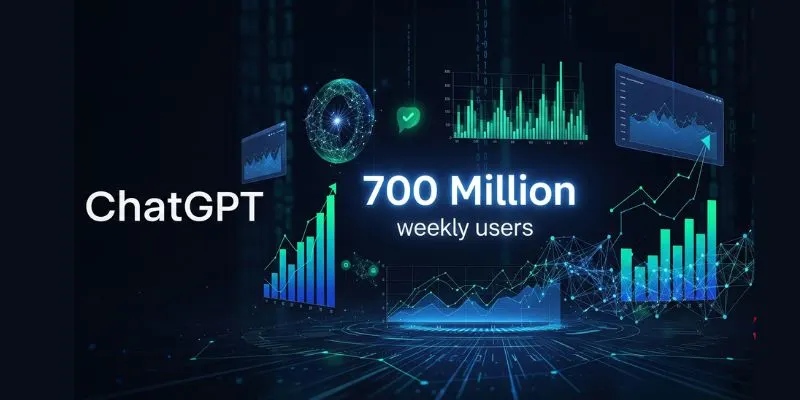700M Weekly Users, Massive Funding, and the Quest for AI Dominance
The generative AI landscape just witnessed another jaw-dropping milestone. OpenAI’s ChatGPT is on track to reach a staggering 700 million weekly active users, marking a more than fourfold surge in just one year and demonstrating beyond doubt that conversational AI is fast becoming a default digital companion for people and businesses worldwide.
But phenomenal user growth is only one part of the story. Let’s dig into the numbers, features, business adoption, financial realities, and what the future holds for OpenAI and its shiny new AI-powered universe.
The Unstoppable Rise: ChatGPT’s User Explosion
It’s not every year a tech product quadruples its user base, but that’s exactly what ChatGPT has achieved. The chatbot, launched broadly in late 2022, now counts 700 million weekly active users, shooting up from 500 million in March 2025, and leaving traditional growth curves in the dust.
What’s even more striking? Daily user messages now exceed 3 billion, and OpenAI is recording an ever-widening range of queries, tasks, and applications—from school homework and career coaching to research, code generation, and novel business workflows. It’s no wonder that AI-powered tools now comprise over 5% of desktop searches in the United States—double their share from just a year ago.
| Statistic | Value |
|---|---|
| Weekly active users (WAU) | 700 million (projected in August 2025) |
| Growth since March 2025 | From 500 million to 700 million (40% increase) |
| Year-over-year growth | 4x increase from the previous year |
| Daily user messages | Over 3 billion |
| Paid business subscribers | 5 million (up from 3 million in June 2025) |
| Percentage of desktop browser searches in U.S. | 5.6% AI-powered tools (double from last year) |
| OpenAI valuation after latest funding round | $300 billion |
| Latest funding secured | $8.3 billion |
| OpenAI annualized revenue (2025 estimate) | Around $13 billion, projected up to $20 billion by year-end |
Feature Frenzy: The Fuel Behind the Frenzy
So what’s driving this soaring adoption? OpenAI has been on a relentless feature release schedule:
Deep Research Tools and Projects: Users can now build and reference complex research projects, drawing on augmented memory that links chats, documents, and past insights. This makes ChatGPT suitable not just for Q&A, but for genuine knowledge management and repetitive workflows.
Voice Mode and Multimodality: Real-time voice and image support have been expanded, with the upcoming GPT-5 promising an even more unified AI assistant. Imagine text, voice, document analysis, and image understanding working seamlessly together—ChatGPT is no longer just a chatbot, but a “multi-role” digital partner.
Business Integrations and “Everything App” Ambitions: Features like Connectors and Record Mode now allow ChatGPT to access email, drive, and workplace apps, transcribe meetings, generate action items, and summarize documents—directly challenging the likes of Microsoft 365 and Google Workspace.
Enterprise Scaling: 5 million business users (up from 3 million in June) now rely on ChatGPT’s enterprise products, from customer service to strategic decision support. The platform is no longer a personal toy, but a backbone of productivity for Fortune 500s and startups alike.
Wall Street Meets Silicon Valley: Giant Valuation, Larger Burn
Growth at this scale doesn’t come cheap. OpenAI recently closed an $8.3 billion funding round—part of its outsized, record-setting $40 billion capital raise for 2025. Top names like Dragoneer Investment Group, SoftBank, Blackstone, and Andreessen Horowitz piled in, eager for a piece of the AI future.
Valuation? A mind-boggling $300 billion, cementing OpenAI as one of the world’s most valuable private tech companies.
Revenue? OpenAI’s annualized figures have surged to about $13 billion and could top $20 billion by year’s end. That’s powered mainly by ChatGPT Pro, Plus, Team, and Enterprise subscriptions, plus API and custom business solutions.
Cost? Here’s where it gets sobering: OpenAI is projected to burn $8 billion in cash in 2025, primarily driven by massive compute and infrastructure costs required to train and serve enormous next-gen models. Breakeven is likely years away—experts forecast “cash-flow positivity” not before 2029.
Not All Flowers: Competition, Costs, and the AI Arms Race
OpenAI’s marathon sprint is unfolding as rivals like Google DeepMind, Meta, and Anthropic ramp up their own large-scale AI deployments. The “arms race” for both users and enterprise contracts means OpenAI must invest even more to stay ahead—faster model releases, bigger servers, better compliance, and wider product offerings.
Meanwhile, the race to integrate AI into everything—from shopping to document automation—comes with the need for regulatory compliance, security safeguards, and massive continuous upgrades.
Is ChatGPT the Next Digital Superpower?
OpenAI’s ascension is nothing short of extraordinary, and ChatGPT’s exponential rise is reshaping what’s possible at the intersection of AI, productivity, and digital life. The challenges are real (funding, costs, competition), but the current moment feels like a generational inflection point.
One thing is clear: for anyone tracking the future of AI, business, or digital ecosystems, ChatGPT’s 700 million-user milestone is not just another number—it’s a signal that the next phase of the internet is here.


